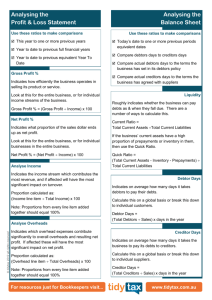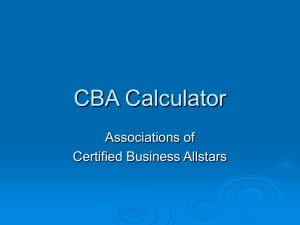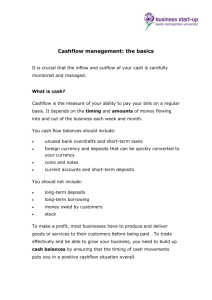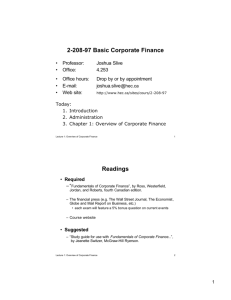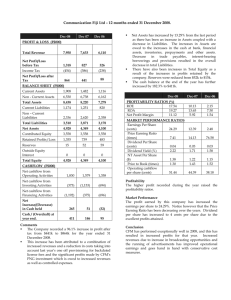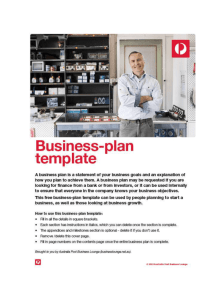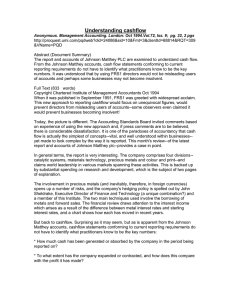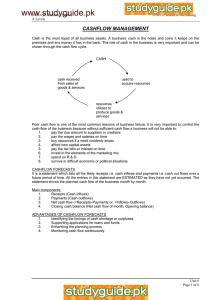www.studyguide.pk BUSINESS Cash Flows
advertisement
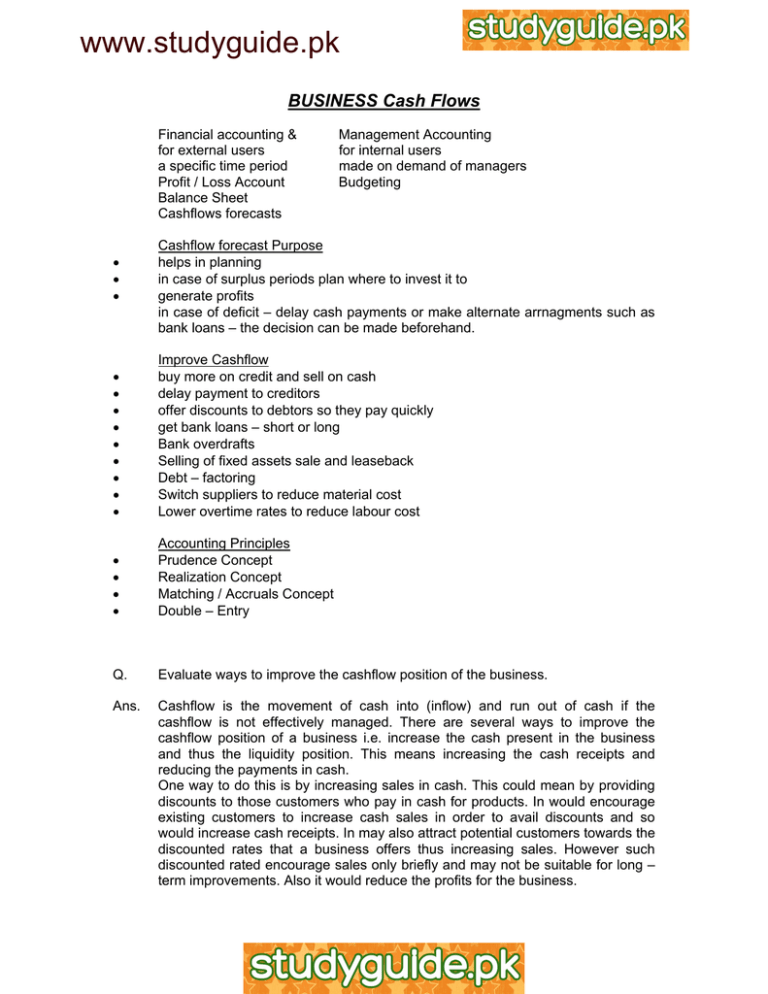
www.studyguide.pk BUSINESS Cash Flows Financial accounting & for external users a specific time period Profit / Loss Account Balance Sheet Cashflows forecasts • • • Management Accounting for internal users made on demand of managers Budgeting Cashflow forecast Purpose helps in planning in case of surplus periods plan where to invest it to generate profits in case of deficit – delay cash payments or make alternate arrnagments such as bank loans – the decision can be made beforehand. • • • • • • • • • Improve Cashflow buy more on credit and sell on cash delay payment to creditors offer discounts to debtors so they pay quickly get bank loans – short or long Bank overdrafts Selling of fixed assets sale and leaseback Debt – factoring Switch suppliers to reduce material cost Lower overtime rates to reduce labour cost • • • • Accounting Principles Prudence Concept Realization Concept Matching / Accruals Concept Double – Entry Q. Evaluate ways to improve the cashflow position of the business. Ans. Cashflow is the movement of cash into (inflow) and run out of cash if the cashflow is not effectively managed. There are several ways to improve the cashflow position of a business i.e. increase the cash present in the business and thus the liquidity position. This means increasing the cash receipts and reducing the payments in cash. One way to do this is by increasing sales in cash. This could mean by providing discounts to those customers who pay in cash for products. In would encourage existing customers to increase cash sales in order to avail discounts and so would increase cash receipts. In may also attract potential customers towards the discounted rates that a business offers thus increasing sales. However such discounted rated encourage sales only briefly and may not be suitable for long – term improvements. Also it would reduce the profits for the business. www.studyguide.pk Another way is by reducing debtor periods i.e. the credit time allowed to customers to pay for the sales. This would result in quicker receipts of sales and reduce the cash tied up in debts. It may also mean a decrease in bad debts which is when a customer becomes totally unable to payback a debt may be because it has gone bankrupt. So the chances of receiving more cash for sales increases. However, the drawback is a loss of customers who may go to firms offering a greater credit period. The firm may also use factoring of debts to release cash from debtors. This is when the company’s debts are sold to a specialist firm which takes the risk of bad debts and the responsibility of collecting them. the firm get quick cash required by it. However the drawback is that a large discount has to be paid to the debt factor as its profit margin. Therefore, the cash received may be less than what the company would have go then from debtors. Also customers usually prefer dealing directly with the business rather than the debt factor. Therefore, there may be a loss of good will amongst customers. Also payments to suppliers could be delayed by asking them for credit period if there is none or by negotiating a longer credit period for the time where a negative cashflow is forecasted. There is no interest charged for delayed payment as is the case in some ways to increase cash. Also there is no need for reductions in capital spending more do any measures have to be taken which result in decreased consumer demand. However, relations with suppliers maybe affected. Suppliers may delay further deliveries of materials until payments are made. This could cause disruption in production lone any may lead to sales to suffer. Also, suppliers may not continue on the best terms and may give a lower quality of raw materials to the business or may even stop trading with the business. They may even start supplying to competitors who pay quickly. Then there is a loss of discounts which are offered by suppliers to business on early payments. Delaying or reduction on capital spending is also one of the ways of improving the cashflow position. Capital spending is the purchasing of equipment, machinery, fixtures and other fixed assets. They usually cause a large drain on the cash reserves of a business. Delaying purchase would have no immediate negative effects nor any adverse effects on suppliers and consumers relationships. However, it may result in long–term in competitiveness for the business due to the lack of updated technology. Old equipment may also become less reliable and inefficient and maintenance cost may get higher which continue a drain on cash. To overcome the disadvantage of delaying purchase, the company would rent or lease equipment. This would greatly reduce the capital costs on a month by month basis. Also since maintenance is responsibility of the leasing company, company saves on these costs. However, the leasing or rental charges become a long – term cash outflow of business and their sun is usually greater than the original cost of equipment. A company could also obtain overdraft or short – term loan. It is a flexible form of finance which can be used at times when firm may be short of cash. It can be arranged before hand by seeing the months where company has cashflow deficit after a cashflow forecast has been prepared. Also this method avoids damage to potential customer or supplier relations which are caused by adopting other methods. However usually there are high interest charges which add to future cash outflows. Then overdrafts could be called back by banks on every short notice and this could lead to business failure in absence of availability of other funds. www.studyguide.pk A company should decide upon the best way to improve cashflow after taking into consideration the advantages and disadvantages of all available methods. Then those which are best suitable to its position should be selected. For example, if it already ahs taken overdrafts or loans then it would have to use some other methods. In case of too many competitors it could not use shorter credit period to debtors. Thus deciding on the best method is very necessary for running of a company. • • • • • • • • • • CASHFLOW AND PROFITS DIFFERENCE FACTORS more credit sales / more debtors more cash purchases depreciation drawings and investments from the owners selling fixed assets cash received from previous sales closing stock prepayments accruals expenses taking bank loans A profitable business may run out cash while a business recording a loss may have cash surplus. How is this payable.


